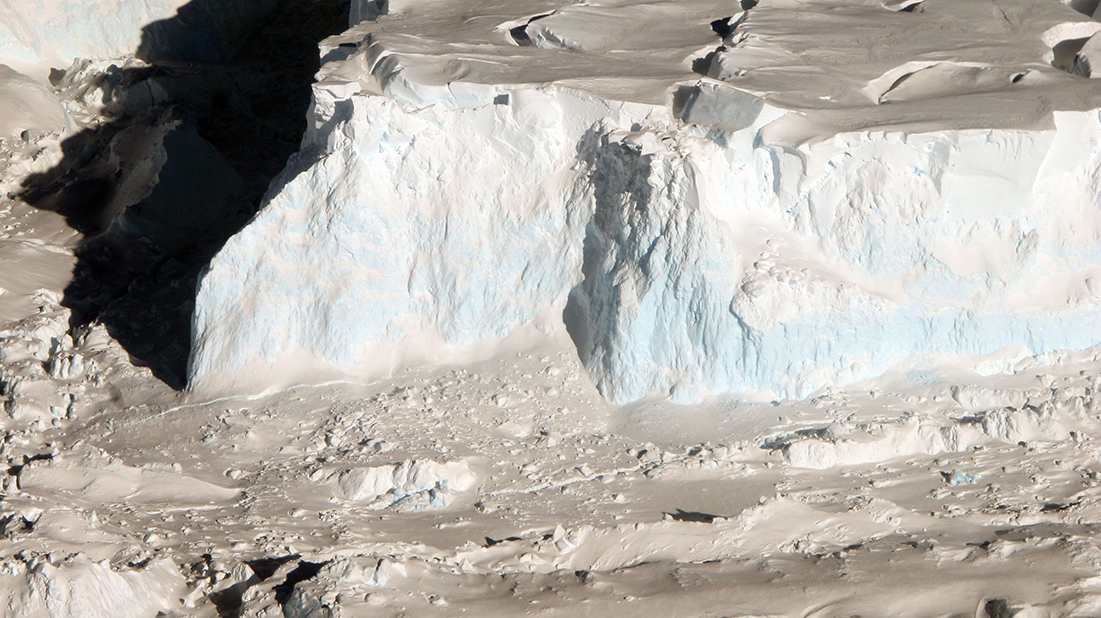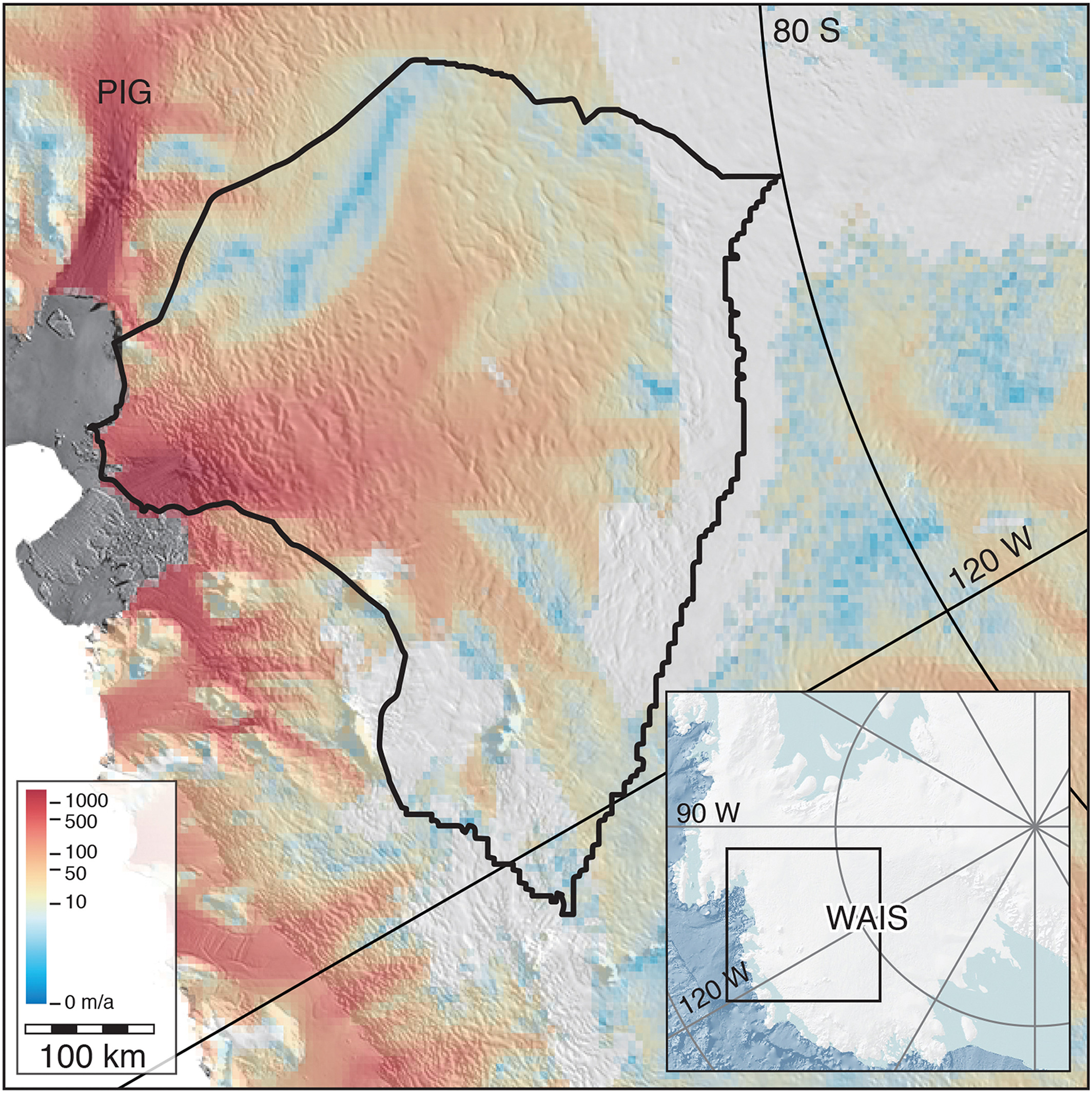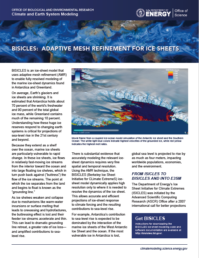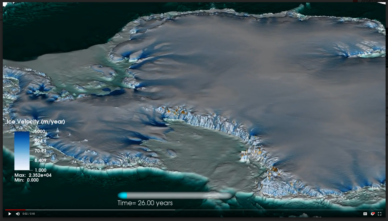Antarctic Ocean Warming Affects Sea Level Rise

The Thwaites Ice Shelf in West Antarctica is one of the largest regional contributors to sea level rise. (Image courtesy of James Yungel, National Aeronautics and Space Administration.)
Near-Term Ocean Warming Around Antarctica Affects Long-Term Rate of Sea Level Rise
Scientists investigate a threshold for rapid ice-sheet degradation in the West Antarctic Ice Sheet.
The Science
In the West Antarctic Ice Sheet, which is particularly susceptible to influencing sea levels, rates of mass loss are especially sensitive near the point at which a glacier or ice shelf transitions into a regime of self-sustained retreat. In this state, the effects of ocean warming and other changes are sustained by the dynamics of a retreating ice sheet, with the rate of glacier loss depending strongly on how quickly the ocean melts the ice shelf. These findings are thanks to a team’s research into the processes that regulate basin-wide ice mass loss.
The Impact
The portions of the West Antarctic Ice Sheet that rest over water contain enough vulnerable ice to raise the global sea level by 3 meters (nearly 10 feet). Recent incursions of warmer water and mass loss from this region will be exacerbated by projected changes in global climate.

BISICLES model catchment boundary for Thwaites Glacier experiments. Color map shows surface speed from Rignot et al. (2011) draped over the MODIS Mosaic of Antarctica (MOA) (Haran et al., 2005)
Summary
The rapid change now underway on Thwaites Glacier, located in the West Antarctic Ice Sheet, raises concern that a threshold for unstoppable grounding line retreat has been or is about to be crossed, after which further retreat is inevitable even in the absence of continued forcing. The grounding line is the point where the base of the glacier is on land. Beyond this point, the glacier is floating in the ocean. To examine processes regulating basin-wide ice mass loss from the West Antarctic Ice Sheet, researchers applied the high-resolution BISICLES ice-sheet model to capture realistic grounding line dynamics at 250-meter resolution. In a set of modeling experiments, they slowly ramped up ocean melting of the surrounding ice shelves to identify the point at which mass loss from melt may become self-sustaining from a change in ice flow dynamics. In the experiments, this occurred at 13 meter/year melt and the system continued to lose mass until nearly all of the West Antarctic Ice Sheet is evacuated. The ice sheet is a critical player in global sea level rise. The study identifies an important characteristic of this change in flow regimes. Near the transition point, small differences in ocean forcing had a long-term effect on discharge rates. The team found that with only 0.5 meter/year additional forcing at the time the system is experiencing this flow transition, discharge rates were upwards of 50 percent higher for centuries. This result is due to the role of added forcing in creating steeper slopes at the grounding line that, in turn, cause higher discharge rates. This positive feedback for the Marine Ice Sheet Instability mechanism means that details concerning how the ocean forces ice sheets across the threshold for instability will be critical for determining long-term rates of sea level rise.
Publication
M.S. Waibel, C.L. Hulbe, C.S. Jackson, and D.F. Martin, “Rate of mass loss across the instability threshold for Thwaites Glacier determines rate of mass loss for entire basin.” Geophysical Research Letters 45, 809 (2018). DOI: 10.1002/2017GL076470
Also visit the Biological and Environmental Research (BER) web page for this publication.
BISICLES
More info on BISICLES can be found in this Technical Highlight:
BISICLES: Adaptive Mesh Refinement for Ice Sheets
Also see the Antarctic Ice Sheet Simulations post:
Contact: Dan Martin, Lawrence Berkeley National Laboratory
Funding: The Department of Energy, Office of Science, Office of Biological and Environmental Research and Advanced Scientific Computing Research (BER/ASCR), and Scientific Discovery through Advanced Computing (SciDAC) supported the research.




